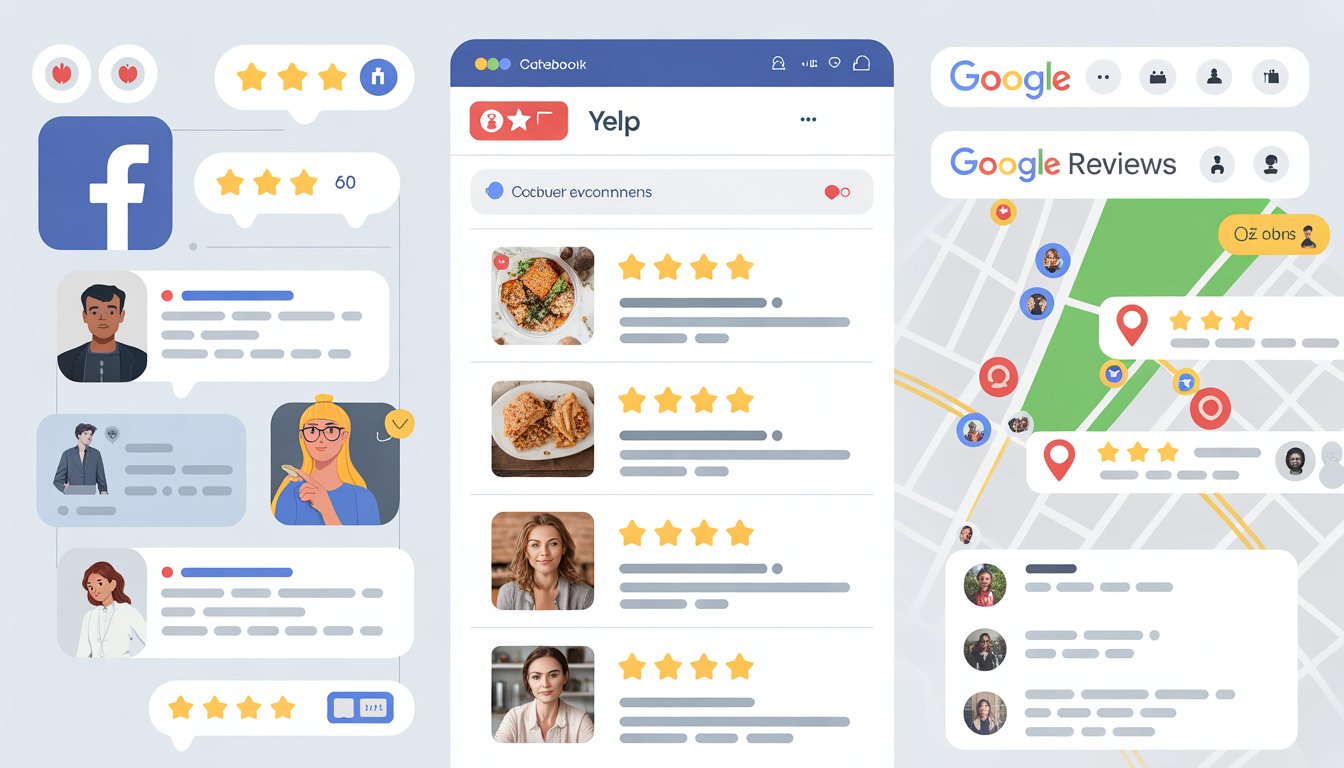Online reviews play a huge role in how people shop today. But younger customers handle reviews very differently than older shoppers.
Adults aged 18-24 trust online reviews more than any other age group and are most likely to be influenced by them when making purchases.

This difference goes beyond just trusting reviews. Young shoppers grew up with social media and digital platforms.
They see reviews as part of their normal shopping process. They also connect reviews to social proof from friends and influencers online.
Young shoppers look for different things in reviews. They use different platforms and make decisions in their own unique way.
Key Takeaways
- Younger customers trust online reviews more than older generations and use them to guide most of their buying decisions
- Digital natives view reviews as social proof similar to recommendations from friends and social media influencers
- Young shoppers prefer authentic, transparent reviews and can spot fake ones more easily than older consumers
Generational Differences in Online Review Behavior

Each generation uses online reviews in distinct ways based on their technology comfort levels and shopping habits. Gen Z consumers trust reviews more than older groups, while Baby Boomers prefer fewer, higher-quality sources before making purchases.
Key Age Groups and Their Digital Habits
Gen Z (ages 13-28) grew up with smartphones and social media. They check multiple review platforms daily and trust peer opinions over brand marketing.
Millennials (ages 29-43) were early internet adopters. They read reviews carefully but also compare prices across websites before buying.
Gen X (ages 44-59) uses reviews but prefers established sites like Amazon. They focus on star ratings and brief summaries rather than long detailed comments.
Baby Boomers (ages 60+) read fewer reviews overall. When they do check reviews, they prefer professional ratings over user-generated content.
Your age group likely influences which devices you use to read reviews. Younger shoppers use mobile phones 80% of the time.
Older consumers still prefer desktop computers for research.
Technology Adoption Among Younger Generations
Younger consumers embrace new review platforms faster than older groups. You'll find Gen Z users on TikTok, Instagram, and newer apps for product recommendations.
They switch between platforms during a single shopping session. A typical Gen Z shopper might check TikTok reviews, read Amazon comments, then ask friends on Snapchat.
Platform preferences by age:
- Gen Z: TikTok, Instagram, Snapchat
- Millennials: Facebook, Amazon, Google Reviews
- Gen X: Amazon, Google, retailer websites
- Boomers: Google Reviews, retailer sites
Mobile-first design matters more for younger users. They expect fast-loading review sections and easy filtering options on their phones.
How Review Usage Varies by Age
Review reading frequency shows clear age differences. Over 90% of consumers read reviews, but younger shoppers read them more often.
Gen Z reads an average of 8 reviews per purchase. Millennials read about 6 reviews.
Gen X reads 4 reviews, while Boomers read only 2-3.
Trust levels vary significantly by generation. Younger consumers show higher trust in online reviews despite knowing some might be fake.
Response to negative reviews differs across age groups. Gen Z expects brands to respond quickly to complaints on social media.
Older consumers prefer email or phone contact for issues.
Review writing behavior also splits by age. Younger shoppers write reviews immediately after purchase, often including photos or videos.
Older consumers write longer, more detailed text reviews but post them less frequently.
Digital Natives and the Role of Social Proof

Gen Z consumers have grown up with technology and social media as core parts of their lives. They rely heavily on what others say and do online before making purchases.
This creates a unique approach to reviews that centers on community feedback and peer validation.
Influence of Peer Reviews and Social Media
You'll find that Gen Z trusts reviews from people their own age more than traditional advertising. Peer validation drives most of their shopping decisions.
Social media platforms like TikTok and Instagram shape how young shoppers discover products. Reviews posted on these platforms carry more weight than reviews on company websites.
User-generated content plays a major role in their decision process. This includes:
- Unboxing videos
- Product testimonials
- Real-time reactions
- Before and after photos
Gen Z consumers look for authentic experiences from people who seem similar to them. They can spot fake or paid reviews quickly because they've grown up online.
Recent studies show that 66% of Gen Z won't buy products if reviews are over a year old. They want fresh feedback that reflects current quality and trends.
The Power of Influencers on Perceptions
Influencers bridge the gap between brands and Gen Z consumers. You see them as trusted sources who test products honestly.
Micro-influencers often have more impact than celebrities. Gen Z values authenticity over fame.
They prefer influencers with smaller followings who engage directly with their audience.
The influence happens through:
- Product demonstrations
- Honest pros and cons
- Real-life usage scenarios
- Response to follower questions
Gen Z watches how influencers interact with products over time. A single post isn't enough.
They want to see ongoing use and honest updates about product performance.
Engagement metrics matter more than follower counts. High likes, comments, and shares signal trustworthy content to young consumers.
Online Communities and Trust-Building
Gen Z creates and joins online communities around shared interests and values. These spaces become powerful sources of product recommendations.
Reddit threads, Discord servers, and Facebook groups offer detailed discussions about products. You get multiple perspectives and can ask specific questions.
Trust builds through:
- Consistent member interactions
- Detailed product experiences
- Honest problem-solving discussions
- Community-verified recommendations
These communities often develop their own review standards. Members call out fake reviews and share red flags about questionable products.
Community moderators help maintain quality discussions. They remove spam and ensure reviews meet group standards.
Gen Z values these spaces because they offer unfiltered opinions. You can find real problems and solutions that companies might not mention in their marketing.
Decision-Making Processes: Younger Customers vs. Older Generations
Younger customers follow a faster, more research-heavy path when making purchases online. They expect fresh information and use multiple sources to compare options quickly.
Research and Comparison-Shopping Behaviors
Younger shoppers cast a wider net when researching products. Gen Z and Millennials check multiple review platforms before buying anything.
They look at social media posts, influencer opinions, and peer feedback. You'll find them reading comments on Instagram, TikTok reviews, and YouTube unboxings.
Older customers take a different approach. Gen X and Baby Boomers focus on fewer but more detailed sources.
They prefer official websites and established review sites. They spend more time reading longer reviews.
These customers value detailed descriptions over quick star ratings.
The comparison process varies too. Younger buyers quickly scan multiple products and switch between options.
They use comparison tools and check prices across several sites. Older shoppers tend to research fewer products more deeply.
They stick with brands they know and trust.
Speed and Expectations for Up-to-Date Feedback
Younger customers want recent reviews. About 66% of Gen Z and Millennials won't buy products if reviews are over a year old.
They need current information to feel confident. They expect reviews from the past few weeks or months.
Anything older feels outdated and unreliable to them.
Older generations are more flexible with review dates. They focus on overall ratings and detailed feedback rather than when it was posted.
Brand reputation matters more than review timing. They're willing to buy products with older reviews if the overall quality seems good.
Response time expectations differ greatly. Younger customers expect quick answers to questions and fast customer service responses.
They want immediate confirmation that their purchase decision is right. Older customers are more patient with slower response times.
They're comfortable waiting for thorough answers.
Trust, Authenticity, and Transparency in Online Reviews
Younger customers have developed keen skills for identifying fake reviews and expect brands to communicate openly. They prioritize real experiences from verified buyers over polished marketing messages.
Spotting Fake vs. Genuine Reviews
Gen Z and Millennial shoppers can quickly identify fake reviews through several key indicators. They look for specific details about the product experience rather than vague praise.
Red flags you should watch for:
- Generic language that could apply to any product
- Reviews posted on the same dates in clusters
- Overly positive language without any negatives mentioned
- Lack of specific product details or usage scenarios
You'll notice younger customers trust verified purchase badges significantly more than unverified reviews. They also value reviews that mention both pros and cons of a product.
Reviews from real users often include photos, specific use cases, and honest feedback about delivery times or packaging.
Fake reviews typically focus only on generic positive statements.
Demand for Transparency and Open Communication
Younger shoppers expect brands to respond openly to both positive and negative reviews. You'll see they trust companies more when negative reviews are visible alongside positive ones.
This generation values authentic communication over perfect ratings. They want to see how businesses handle complaints and resolve issues publicly.
Key transparency elements they look for:
- Brand responses to negative feedback
- Mixed review ratings rather than all 5-stars
- Detailed explanations of product changes or improvements
- Clear policies on review collection and moderation
They need current, transparent feedback to make purchase decisions.
Preferred Platforms and Review Channels
Younger customers gravitate toward mobile platforms and visual review formats instead of traditional desktop sites. They also explore specialized forums and niche review platforms that older generations typically overlook.
Mobile-First Behavior and App Usage
Your younger customers live on their phones. They check reviews through apps rather than desktop websites.
53% of Gen Z made purchases based on review videos in 2024. This shows how much they prefer visual content over text-only reviews.
Mobile apps give them instant access to reviews. They can quickly scan ratings while standing in stores or browsing social media.
Popular mobile review channels include:
- TikTok - Short video reviews and product demos
- Instagram Stories - Quick product feedback and recommendations
- Snapchat - Real-time product experiences shared with friends
- YouTube Shorts - Detailed product breakdowns in bite-sized videos
Your review collection needs to work on mobile first. QR codes work well for younger customers.
They can scan and leave reviews in seconds. Text message review requests get better response rates than emails.
Keep the process to one or two taps maximum.
Role of Niche Review Sites and Forums
Younger customers dig deeper than Google Reviews or Yelp. They find specialized platforms that match their interests.
Reddit serves as a major review source. Subreddits like r/BuyItForLife or product-specific communities offer detailed discussions.
Discord servers host live review conversations. Gaming products, tech gadgets, and beauty items get reviewed in real-time chats.
Platform specialization matters:
CategoryPreferred PlatformsBeautySephora app, Ulta reviews, beauty TikTokGamingSteam reviews, Discord, TwitchFashionInstagram, Pinterest, brand-specific appsFoodUber Eats, DoorDash, local Facebook groups
Your younger customers trust these niche platforms more than general review sites. They value opinions from people who share their specific interests.
These platforms often have stricter authenticity standards. Fake reviews get called out quickly by community members.
Impact of Online Reviews on Brand Perceptions and Loyalty
Younger customers use online reviews to shape their long-term relationships with brands. Their reactions to negative feedback and decisions about repeat purchases differ significantly from older generations.
How Younger Customers Respond to Negative Feedback
Gen Z and Millennials view negative reviews as learning opportunities rather than deal-breakers. You will notice they read criticism to understand potential problems before buying.
These younger shoppers expect brands to respond to negative feedback quickly. When companies ignore complaints, 73% of younger customers lose trust in the brand permanently.
Key Response Patterns:
- They check how brands handle criticism
- They value honest, detailed negative reviews
- They expect public responses within 24-48 hours
- They share their own negative experiences more openly
Your younger customers also use negative reviews to negotiate better deals. They reference specific complaints when contacting customer service for discounts or upgrades.
Social media amplifies their negative experiences. One bad review can reach hundreds of their followers within hours through stories and posts.
Influence on Repeat Purchases and Advocacy
Recent positive reviews drive younger customers to become repeat buyers. You need reviews posted within 90 days to maintain their interest in your products.
Advocacy Behaviors:
- Photo Reviews: 62% of younger customers post pictures with their reviews.
- Social Sharing: They share positive experiences on 3-4 platforms on average.
- Referral Actions: 84% recommend products to friends after leaving positive reviews.
Your younger customers become brand ambassadors when they see their reviews acknowledged. Simple "thank you" responses increase their likelihood of future purchases by 45%.
They create detailed reviews that influence their peer groups directly. These customers write longer, more specific feedback that drives purchasing decisions among their social circles.
Frequently Asked Questions
Younger consumers show unique patterns in how they interact with online reviews. They demonstrate higher trust levels than older generations while also being more skilled at spotting fake content.
What influences Generation Z's trust in online reviews?
Gen Z leads all age groups in trusting online reviews despite declining trust across the general population. They have grown up with digital content and feel comfortable navigating online information.
This generation values authentic experiences over polished marketing messages. They look for reviews that feel genuine and include specific details about products or services.
Gen Z also trusts reviews more when they come from platforms they use regularly. Social media reviews often carry more weight than traditional review sites for this age group.
How do millennials compare to previous generations in using online reviews?
Millennials read online reviews more frequently than older consumers. They actively seek out multiple sources before making purchasing decisions.
Unlike older generations, millennials are more likely to leave negative reviews when they have poor experiences. They view reviewing as a way to help other consumers and hold businesses accountable.
Millennials also use a wider variety of review platforms compared to older consumers. They check social media, specialized review sites, and e-commerce platforms before buying.
To what extent do online reviews impact a young consumer's purchasing decision?
Online reviews heavily influence younger consumers' buying choices. Most young shoppers read reviews before making any significant purchase decision.
Younger consumers often won't buy products or services with consistently poor reviews. They use star ratings as a quick filter to narrow down their options.
The impact is strongest for products they haven't tried before. Young consumers rely on reviews to reduce uncertainty when buying unfamiliar items.
What type of online review content is most effective with a younger audience?
Younger consumers prefer detailed reviews that include specific examples. They want to know exactly what to expect from their purchase experience.
Photo and video reviews resonate strongly with young audiences. Visual content helps them better understand products before buying.
Recent reviews carry more weight than older ones for younger consumers. They want current information that reflects the latest product versions or service quality.
How do younger consumers balance the credibility of online reviews with personal recommendations?
Young consumers still value personal recommendations from friends and family. However, they often use online reviews to verify these suggestions.
They cross-reference multiple sources before making decisions. Personal recommendations might spark interest, but online reviews help confirm choices.
Younger consumers are better at spotting fake reviews than older generations. Those under 44 years old are most likely to notice fraudulent content.
In what ways do consumer behaviors vary between digital natives and older consumers regarding online reviews?
Digital natives use more review platforms than older consumers. They check social media, apps, and websites that older generations might not know about.
Younger consumers are more willing to challenge existing review consensus. They're more likely to leave positive reviews when they disagree with low ratings.
Older consumers focus mainly on major platforms like Google and Yelp. They tend to leave more positive reviews overall.
Digital natives also engage more actively with review content. They're more likely to share their own experiences online.










